Cats are well known for being fussy eaters. Many pet parents will face some problems when it comes to feeding cats, and if you have more than one cat, your issues are doubled! In our cat food and feeding guide, we’ll explore how much food to feed a cat, do they need wet food, and what foods can cats eat. We’ll also answer some common questions, including, can cats eat dog food and if they can be kept healthy on a vegan diet.
Cats are curious creatures, and they’ll eat all sorts of things around the home. However, you need to ensure they are not eating or chewing anything harmful (e.g., needle and thread). A cat will happily munch on bugs, plants, and insects. If they are allowed to roam free at night, cats are efficient hunters and will catch all types of prey; they are one of the few animals to hunt for sport. Keeping your cats inside, or walking them on a lead, is the best way to keep your cat from harming other animals and allow you to control their food intake.
When do I feed my cat?
Cats can set their own timetable for feeding times and usually, they’ll have one large meal per day, or they’ll graze and have multi small meals in a day. A grazing cat can have food left out for the entire day (unless it’s wet), but if they’re overeating (i.e., gaining weight), you may need to encourage them into a dedicated routine of suitably sized meals once or twice per day.
Meal feeding your cat
Meal feeding relates to when you fill up your cat’s bowl with the recommended amount, and then you pack away the bowl after they’ve finished eating. In meal feeding, you can use dry and wet food or a mix of both. Some cats can eat their entire daily meal in one sitting, and others may need their daily ration split up into two separate meal times.
In homes of two or more cats, each should have a dedicated space for feeding and drinking. Cats prefer to eat by themselves and to left alone. If you don’t have a separate space for your cats, you can try feeding them at different times.
Grazing or free feeding cats
When you free feed your cats, their food is out all day and available when they choose to eat. This feeding style is very flexible, but you have little control over how much they eat in a day. You should only use dry food when free feeding because wet food will quickly go wrong if left in the bowl for more than twenty minutes. Dry food should be replaced after it has been in the bowl for more than 12 hours.
Free feeding can be problematic with homes of two or more cats as you may not know which cat is eating the food. It is possible you have one cat eating more than its fair share, and the other is missing out.
If you have a cat on a medicated diet, you should not be free feeding, as most diets have strict guidelines for how much your cat needs daily.
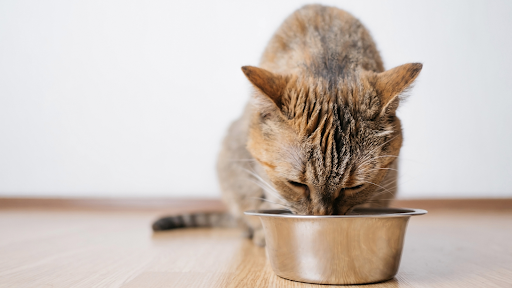
Can cats eat dog food?
Many homes in Australia will have a mix of dogs and cats, and questions of, ‘can cats eat dog food?’ is often asked because the cat will take a few bites of the dog’s food. Dogs and cats are two different animals, and they both have unique dietary requirements. Dogs are omnivores, and they can eat a similar diet to humans, although they’ll usually have a higher meat content. Cats are obligate carnivores, meaning they need a meat diet to survive.
Cats lack the internal working to process plant materials properly. If they ingest plants (which they will occasionally do), it will generally pass directly through their system, and they will not get any nutritional benefit.
When breaking down cat foods, you’ll see that it is predominantly meat. You may find that cat kibble will contain some plant matter, but this is used to bind the food into a shape, and it offers no nutritional value. When you examine dog food kibble, you’ll note quite a bit of plant matter included. In addition to helping the food bind, this plant matter aims to give your dog the right balance of nutritional elements.
So, can cats eat dog food? The answer is a yes, but not as a regular food source. If you’ve run out of cat food and it’s only one meal, this will be fine, but it should never be a long-term arrangement.
Can cats be vegan?
No, cats cannot be vegan. As pet owners, our responsibility is to make sure your pet has a long and healthy life. Cats cannot effectively draw nutrients from plant-based sources, and by keeping them on a vegan diet, they are effectively being starved.
Cats are natural prey hunters and will consume all types of meat. If a cat is fed a vegan diet and then goes outside, it will supplement its ‘food’ by hunting and eating as many other animals as possible. If you’re concerned about feeding your cat a meat-based diet, then it may be best not to have a cat as a pet. Animals like rabbits, guinea pigs, birds, and rats all make excellent pets, and these will all eat a vegan diet.
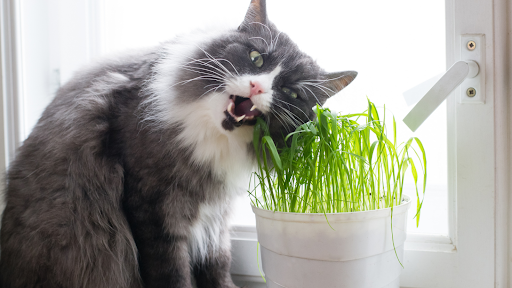
How much food to feed a cat?
When considering how much food to feed a cat, there are several traits you need to consider. For example, your cat’s age will significantly affect how much food you can give to them. You’ll also find that the type of food you feed will have its feeding guide. It is best to follow these to make sure your cat gets the correct amount.
The feeding guide on the packet is only a guide. Your cat will need different amounts of food based on their activity. If you have a cat that likes to lie about and doesn’t do too much, then it’ll need less food. If it’s active for most of the day it will need more. When you first get a cat, you can start by following the feeding guide. Some feeding guides are measured in cups, and others use grams. Using grams is a better option as often cups are not related to standard measuring cups, but that brands specific cup measure. If you have a standard cup or other measuring devices, you can weigh 100 grams and mark the level. Using this tool, you can estimate how much food to feed your cat without weighing it each time.
In addition to how much food to feed a cat, you need to decide how often you’re going to feed them. Kittens (under 10mths) should be fed 2-3 times a day. They will burn through food quickly because they’re growing and very active. Adult cats (10mths+) will need feeding 1-2 times per day based on their needs. Senior cats (over 12yrs) may need feeding whenever they ask for food. They may only eat a small amount at a time.
Do cats need wet food? Do cats need dry food?
Cat food comes in three primary forms, dry, wet, and raw. All of these feeding types have positives and negatives, and the one you choose can rely upon what you deem the best for your home. It’s important to note that there are no nutritional differences between these types of food. Whichever one you choose, your cat will be happy and healthy.
Dry Cat Food
Dry cat food is perfect for feeding a cat that does not like to keep strict feeding times. You can give them the correct amount of food for the day, and then they can graze at their leisure. This has advantages over wet and raw foods as these must be removed and disposed of after about 30 minutes.
Dry food is excellent for helping with your cat’s dental cleaning. Dry kibble can act as a tooth cleanser, and your cat needs to spend time chewing. This scrapping action can help clean your cat’s teeth by removing particles of food. You can buy special oral care kibble foods for more stubborn tooth problems. Dry food is cheaper to purchase, and there is less package wastage.
Wet Food
If you’ve thought about do cats need wet food, it’s likely because you’re not keen on the smell or the time it takes to prepare. However, there are advantages and reasons that you may consider feeding your wet cat food. If your cat tends to be fussy, then a highly aromatic wet food can be the best choice for them. You can also find wet cat food in a variety of different flavours.
Wet cat food helps with urinary tract infections. As cats have a low thirst drive and will often not drink enough water. Low water consumption can lead to urinary infections if your cat is solely on a dry diet. Most wet foods contain a lot of water to help hydrate your cat.
Raw Food
Raw food is uncooked meat. You can give this directly to your pet, although some cats prefer it to be slightly warmed. A raw cat food diet can consist of all meat. Sometimes they are made with mixed in grains to help the food pass through their system.
Raw food is an excellent food for your cat. However, you need to keep it refrigerated (or frozen), and the preparation can take longer than other foods. You can buy commercial raw foods made to meet the nutritional requirements of your cat from most specialty pet retailers.
What foods can cats eat?
Cats can enjoy a wide variety of foods other than their traditional wet and dry food. If your kitty is looking longingly at you while you eat some food, you may wonder, what foods can cats eat and is it okay if they eat something off your plate?
All meat is safe for cats to eat, and as they tend to lick or nibble meat off the bone, they are not likely to have an issue with swallowed bones. However, if you’re feeding fish, you should remove all the bones as these can cause an issue.
There are several fruits and vegetables that cats can enjoy, although they won’t get any nutritional benefits. If you’re unsure, it may be best to talk with your veterinarian. Some cat-safe foods include:
- Blueberries – check there are no stalks included, and you can freeze these for a treat on a warm day.
- Bananas – remove the peel and use bananas that are not overly ripe.
- Watermelon – take all the seeds out and cut this into bite-sized chunks.
- Apples – peel and core apples for a sweet treat for your cat.
- Strawberries – remove the stems and cut larger strawberries in half.
All fruit should be washed and free from any pesticides before giving it to your cat. If your cat does not eat the offering quickly, make sure you collect it and place it in the bin. Avoid giving processed foods as these can have preservatives that may not agree with your cat’s system. Also, avoid any dairy products (milk, cheese, etc.) as many cats are lactose intolerant.

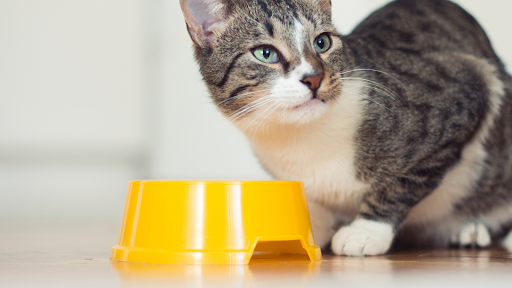
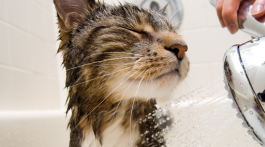
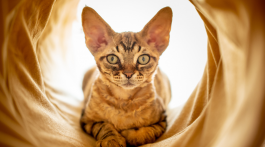
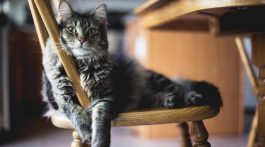
No Comment